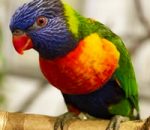 Many people have been wondering about why some of the Lehigh Valley Zoo’s avian species have been off exhibit since late February. We wanted to take some time to address some of the more commonly asked questions about bird flu and the impact it has had on the birds that call the zoo home.
Many people have been wondering about why some of the Lehigh Valley Zoo’s avian species have been off exhibit since late February. We wanted to take some time to address some of the more commonly asked questions about bird flu and the impact it has had on the birds that call the zoo home.
What is Avian Influenza?
According to the CDC, “Avian influenza refers to disease in birds caused by infection with avian (bird) influenza (flu) Type A viruses.” There are 2 categories of Avian Influenza A viruses. For the Low Pathogenic Avian Influenza (LPAI), birds can be infected but be asymptomatic, meaning they carry the virus but are not showing symptoms, or may have mild symptoms, but it does have the potential to mutate into Highly Pathogenic Avian Influenza (HPAI). Highly Pathogenic Avian Influenza is much more serious and has a higher mortality rate. This disease is highly contagious and can be spread through contact with saliva, nasal secretions, and feces from infected birds. The HPAI strain currently affecting birds was first detected in North America in December of 2021. There have been several outbreaks of HPAI in the US (and worldwide) with the last major outbreak being in 2014-2015 and the most recent confirmed detection of an HPAI strain in the US occurring in 2020. Since then, 40,088,443 cases of infected poultry have been reported in 40 states here in the US.
Is bird flu zoonotic, and what does that mean?
 Zoonotic diseases are infectious diseases that are spread from animals to humans (or vice versa). They can be caused by viruses, bacteria, parasites, or fungi. In the case of HPAI, it is possible for humans to contract the disease, but the CDC considers the risk to the general public to be very low. Bird flu cases in humans are very rare with only one case having been reported in the US for the current avian flu outbreak. The people most at risk for contracting bird flu are those with job related or prolonged exposure to infected birds.
Zoonotic diseases are infectious diseases that are spread from animals to humans (or vice versa). They can be caused by viruses, bacteria, parasites, or fungi. In the case of HPAI, it is possible for humans to contract the disease, but the CDC considers the risk to the general public to be very low. Bird flu cases in humans are very rare with only one case having been reported in the US for the current avian flu outbreak. The people most at risk for contracting bird flu are those with job related or prolonged exposure to infected birds.
What can I do to help?
The CDC recommends avoiding contact with wild birds and trying to just observe them from a distance. They also recommend avoiding contact with wild or domestic birds that appear to be sick or that have died. Instead, you can check with your state health department, state veterinary diagnostic laboratory, or state wildlife agency for information about how to report sick or dead birds in your area and what procedures they would like you to follow.
What is the zoo doing to protect their birds?
 Like many zoos in the US, the Lehigh Valley Zoo chose to move the most susceptible species indoors to eliminate contact with wild birds on zoo grounds. Other precautions taken include higher levels of biosecurity for birds, personal protective equipment for staff, and restricted access to bird areas. Due to the proximity of positive cases, barnyard birds, waterfowl and penguins were brought inside in February since they are most at risk. Should cases be reported closer to the Lehigh Valley, the staff is prepared to act quickly to safely move the rest of our birds off exhibit. Committed to protecting the birds in our care, the zoo will continue to work closely with other zoos, the USDA, and the Pennsylvania Department of Agriculture to stay current and abreast of any new updates.
Like many zoos in the US, the Lehigh Valley Zoo chose to move the most susceptible species indoors to eliminate contact with wild birds on zoo grounds. Other precautions taken include higher levels of biosecurity for birds, personal protective equipment for staff, and restricted access to bird areas. Due to the proximity of positive cases, barnyard birds, waterfowl and penguins were brought inside in February since they are most at risk. Should cases be reported closer to the Lehigh Valley, the staff is prepared to act quickly to safely move the rest of our birds off exhibit. Committed to protecting the birds in our care, the zoo will continue to work closely with other zoos, the USDA, and the Pennsylvania Department of Agriculture to stay current and abreast of any new updates.
When will the birds be going back on exhibit?
For the safety and well-being of our birds, they will remain off exhibit until the threat of exposure has decreased. Biosecurity protocols will be able to be relaxed gradually as the threat decreases. The risk to our birds is measured using many different factors including the distance from the zoo of positive cases and the number of cases being reported. With many strains of the same virus, experts are still working to estimate how long this virus can affect birds in the U.S.
What have the birds been up to behind the scenes?
 While in quarantine, our birds have been keeping our animal care staff on their toes! Caring for our birds in quarantine has presented the keepers with many new challenges, including finding ways to provide the best care possible while minimizing contact. They have continued providing enrichment and training opportunities to ensure our birds continue to have the chance to exhibit natural behaviors and to provide mental and physical stimulation. One way they accomplish this is by now using a cup for training to minimize contact with their food and not using tactile reinforcers like handling. Dance parties are a huge hit with our lorikeets and cockatoos; our birds really enjoy getting their groove on! Additionally, our keepers try to go above and beyond by bringing as much of the outside world to our birds as possible. They do this by building indoor forests for them and by moving perching so they can “people watch” through the windows in their holding areas.
While in quarantine, our birds have been keeping our animal care staff on their toes! Caring for our birds in quarantine has presented the keepers with many new challenges, including finding ways to provide the best care possible while minimizing contact. They have continued providing enrichment and training opportunities to ensure our birds continue to have the chance to exhibit natural behaviors and to provide mental and physical stimulation. One way they accomplish this is by now using a cup for training to minimize contact with their food and not using tactile reinforcers like handling. Dance parties are a huge hit with our lorikeets and cockatoos; our birds really enjoy getting their groove on! Additionally, our keepers try to go above and beyond by bringing as much of the outside world to our birds as possible. They do this by building indoor forests for them and by moving perching so they can “people watch” through the windows in their holding areas.
As always, the Lehigh Valley Zoo and all of our birds appreciate your support and understanding during these challenging times. Follow us on Facebook for updates and to watch for when we have been cleared to safely put our most susceptible birds back on exhibit.
Written by Tara Mlodzienski
Education Specialist
Lehigh Valley Zoo | Schnecksville, PA
Sources:
cdc.gov
aphis.usda.gov
padls.agriculture.pa.gov
usgs.gov
lvzoo.org


